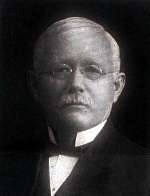North China Theological Seminary
North China Theological Seminary (Chinese: 华北神学院; pinyin: Huáběi Shénxuéyuàn) was one of the largest and well-known fundamentalist Protestant seminaries in mainland China in the first half of the twentieth century. It was founded in 1919 and was eventually merged into Nanjing Union Theological Seminary after the establishment of the People's Republic of China.
History

The North China Theological Seminary was established in 1919 out of a split from the Shandong Christian University, the latter of which was divided over a number of theological and administrative issues. Watson Hayes, originally the acting dean of the theological college of Shandong Christian University, was trusted by Chinese churches and appointed as the first principal of North China Theological Seminary.[1] Established during the fundamentalist-modernist controversy in North America, North China Theological Seminary placed the authority of the bible at a central place in the vision of the seminary. During the 1930s, some would even consider in the "Westminster Seminary of China," named as such due to the role that Westminster Theological Seminary in Philadelphia played in the fundamentalist-modernist controversy.[2]
Chinese Christians played an important role in founding and leading the seminary, as well as providing for its financial needs.[2] Some of its most notable faculty include well-known Chinese Christians such as Ding Limei and Jia Yuming.[3][4] Presbyterian missionaries associated with the seminary also took interest in the rise of independent Chinese evangelists such as John Sung, Watchman Nee, and Wang Mingdao, seeing their preaching as representing the "pure gospel" which called for repentance from one's sins.[2]
After the establishment of the People's Republic of China, North China Theological Seminary would be incorporated into Nanjing Union Theological Seminary.
See also
- Watson Hayes
- Nanjing Union Theological Seminary
- Fundamentalist-Modernist Controversy
References
- Stockment, Martha. "Watson Hayes". Biographical Dictionary of Chinese Christianity. Retrieved 22 June 2016.
- Yao, Kevin Xiyi (2003). The Fundamentalist Movement Among Protestant Missionaries in China, 1920-1937. Lanham, MD: University Press of America. pp. 139–182. ISBN 9780761827405.
- Li, Yading. "Ding Limei". Biographical Dictionary of Chinese Christianity. Retrieved 22 June 2016.
- "Jia Yuming". Biographical Dictionary of Chinese Christianity. Retrieved 22 June 2016.